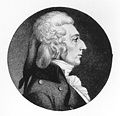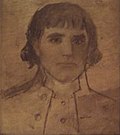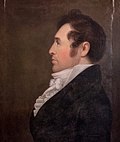Cong
ress | Years | Seat A | | Seat B |
|---|
| Representative | Party | Electoral history | Representative | Party | Electoral history |
|---|
| 1st | August 31, 1790 –
March 3, 1791 | 
Benjamin Bourne
(Bristol) | Pro-Admin | Elected in August 1790.
Re-elected in October 1790.
Re-elected in 1792.
Re-elected in 1794.
Re-elected in 1796, but declined the seat and resigned. | Seat created in 1793 |
|---|
| 2nd | March 3, 1791 –
March 3, 1793 |
|---|
| 3rd | March 3, 1793 –
March 3, 1795 | 
Francis Malbone
(Newport) | Pro-Admin | Elected in 1792.
Re-elected in 1794.
Retired. |
|---|
| 4th | March 4, 1795 –
1796 | Federalist | Federalist |
|---|
1796 –
November 15, 1796 | Vacant |
November 15, 1796 –
March 3, 1797 | 
Elisha Reynolds Potter
(Kingston) | Federalist | Elected to finish Bourne's term and to the next term.
Resigned. |
| 5th | March 4, 1797 –
1797 | 
Christopher G. Champlin
(Newport) | Federalist | Elected in 1796.
Re-elected in 1798.
Lost re-election. |
|---|
1797 –
November 13, 1797 | Vacant |
November 13, 1797 –
March 3, 1799 | Thomas Tillinghast
(East Greenwich) | Federalist | Elected to finish Potter's term.
Lost re-election. |
| 6th | March 4, 1799 –
March 3, 1801 | 
John Brown
(Providence) | Federalist | Elected in 1798.
Lost re-election. |
|---|
| 7th | March 4, 1801 –
March 3, 1803 | Joseph Stanton Jr.
(Charlestown) | Democratic-Republican | Elected in 1800.
Re-elected in 1802.
Re-elected in 1804.
Retired. | Thomas Tillinghast
(East Greenwich) | Democratic-Republican | Elected in 1800.
Lost re-election. |
|---|
| 8th | March 4, 1803 –
March 3, 1805 | Nehemiah Knight
(Cranston) | Democratic-Republican | Elected in 1802.
Re-elected in 1804.
Re-elected in 1806.
Died. |
|---|
| 9th | March 4, 1805 –
March 3, 1807 |
|---|
| 10th | March 4, 1807 –
March 3, 1808 | 
Isaac Wilbour
(Little Compton) | Democratic-Republican | Elected in 1806.
Lost re-election. |
|---|
March 4, 1808 –
June 13, 1808 |
June 13, 1808 –
November 11, 1808 | Vacant |
November 11, 1808 –
March 3, 1809 | 
Richard Jackson Jr.
(Providence) | Federalist | Elected August 30, 1808 to finish Knight's term and seated November 11, 1808.
Also elected the same day to the next term.
Re-elected in 1810.
Re-elected in 1812.
Retired. |
| 11th | March 4, 1809 –
March 3, 1811 | 
Elisha Reynolds Potter
(Kingston) | Federalist | Elected in 1808.
Re-elected in 1810.
Re-elected in 1812.
Retired. |
|---|
| 12th | March 4, 1811 –
March 3, 1813 |
|---|
| 13th | March 4, 1813 –
March 3, 1815 |
|---|
| 14th | March 4, 1815 –
March 3, 1817 | John Linscom Boss Jr.
(Newport) | Federalist | Elected in 1814.
Elected in 1816.
Retired. | 
James Brown Mason
(Providence) | Federalist | Elected in 1814.
Elected in 1816.
Retired. |
|---|
| 15th | March 4, 1817 –
March 3, 1819 |
|---|
| 16th | March 4, 1819 –
December 17, 1820 | 
Samuel Eddy
(Providence) | Democratic-Republican [a] | Elected in 1818.
Re-elected in 1820.
Re-elected in 1822.
Lost re-election. | Nathaniel Hazard
(Newport) | Democratic-Republican | Elected in 1818.
Lost re-election then died. |
|---|
December 17, 1820 –
March 3, 1821 | Vacant |
| 17th | March 4, 1821 –
March 3, 1823 | Job Durfee
(Tiverton) | Democratic-Republican [a] | Elected in 1820.
Re-elected in 1822.
Lost re-election. |
|---|
| 18th | March 4, 1823 –
March 3, 1825 |
|---|
| 19th | March 4, 1825 –
March 3, 1827 | 
Tristam Burges
(Providence) | Anti-Jacksonian | Elected in 1825.
Re-elected in 1827.
Re-elected in 1829.
Re-elected in 1831.
Re-elected in 1833.
Lost re-election. | Dutee Jerauld Pearce
(Newport) | Anti-Jacksonian | Elected in 1825 on the second ballot.
Re-elected in 1827.
Re-elected in 1829.
Re-elected in 1831.
Re-elected in 1833.
Re-elected in 1835.
Lost re-election. |
|---|
| 20th | March 4, 1827 –
March 3, 1829 |
|---|
| 21st | March 4, 1829 –
March 3, 1831 |
|---|
| 22nd | March 4, 1831 –
March 3, 1833 |
|---|
| 23rd | March 4, 1833 –
March 3, 1835 | Anti-Masonic |
|---|
| 24th | March 4, 1835 –
March 3, 1837 | 
William Sprague III
(Natick) | Whig | Elected in 1835.
Retired. |
|---|
| 25th | March 4, 1837 –
March 3, 1839 | Robert B. Cranston
(Newport) | Whig | Elected in 1837.
Re-elected in 1839.
Re-elected in 1841.
Retired. | Joseph L. Tillinghast
(Providence) | Whig | Elected in 1837.
Re-elected in 1839.
Re-elected in 1841.
Retired. |
|---|
| 26th | March 4, 1839 –
March 3, 1841 |
|---|
| 27th | March 4, 1841 –
March 3, 1843 |
|---|